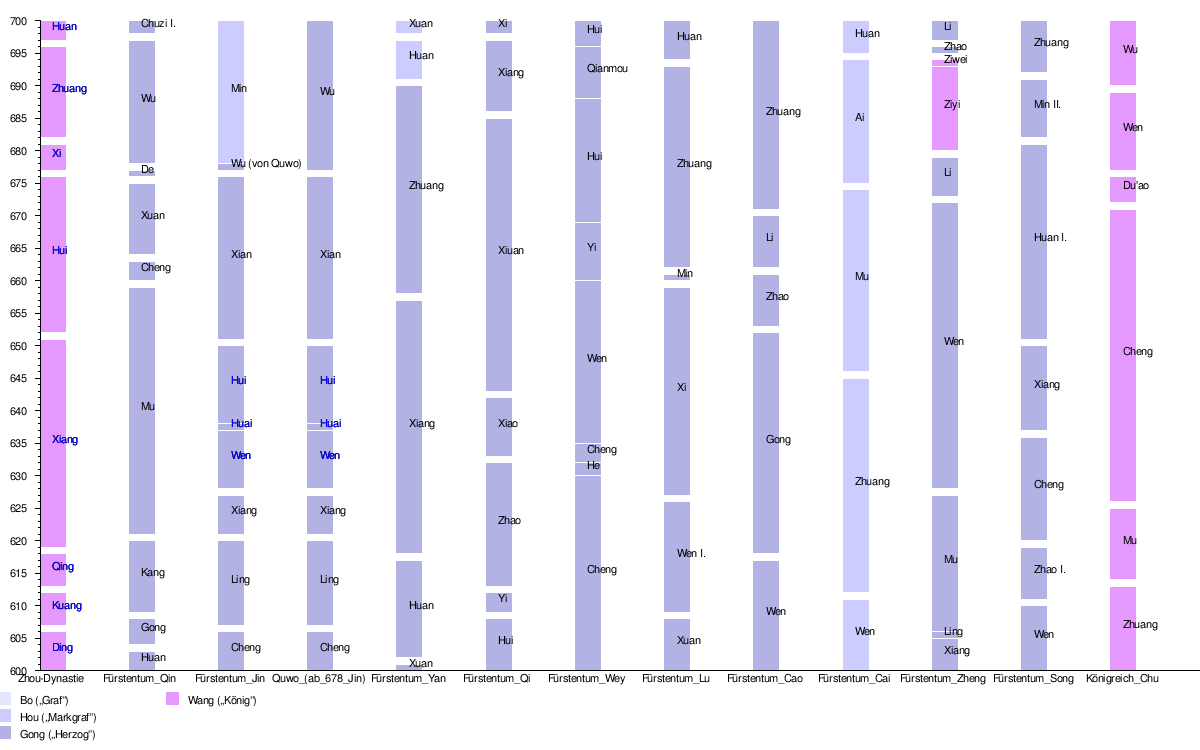List of rulers in the 7th century BC Chr.
Overview
9th century BC Chr. | 8th century BC Chr. | List of rulers in the 7th century BC Chr. | 6th century BC Chr. | 5th century BC Chr.
More events
This is a synchronous representation of the reigns of early ancient rulers in the 7th century BC , visualized in the form of equally scaled timelines.
Africa / Egypt
Middle East

China
Remarks
In Egypt, the Sais dynasty as an Assyrian vassal recaptured the still Cushitic upper Egyptian and saw itself as the legitimate rule of Egypt with the collapse of Assyria. Nissen (2012) once again gives reigns for Egypt with the end of the Kushitic dynasty: Taharka as above; for Tanutamun: 664-656; for his successor Psammetich: 664-610. These are the last Egyptian kings listed in Nissen.
For Urartu, the Assyrian reporting on the kings breaks off in this century after Rusa II, Urartu existed until the 6th century. After that, however, the archaeological evidence is weak.
Of the Chinese states of the spring and autumn annals , only the larger principalities are listed.
For the period 700-600 BC there are further details about rulers that are not listed here for various reasons. These include mythical ancestral kings, but also rulers, who cannot be precisely fixed in time. See for example the lists of the kings of Ireland , Carthage , Rome , Cyrene , Byblos , Tyros , Argos , Sparta , Corinth , the Scythians , Vietnam , Korea and Japan .
Deputies and viceroys are only listed here if the territory they administer formed an independent state before or afterwards. A borderline case here is the Kingdom of Judah, which was actually more of a vassal state of the Assyrians and Egyptians and perished in 598. For the dating of the Judeans see List of Kings of Israel .
General
In the timeline, a gap of one year symbolizes that the transition between two rulers will be assumed around this time. If the transition period can be determined more precisely, this is indicated by a thinner line. Larger gaps between two names do not necessarily mean that there was no ruler; but indicate an uncertainty. If no colored bars are displayed, the relevant rulers cannot be dated more precisely according to the latest research. The representation does not claim to be complete.
Specifically, the dating according to Nissen (2012) is used here for the information on ancient oriental kings and the dating according to Beckerath (1994) for the information on Egyptian kings.
General note: Some of the years in this list cannot be determined more precisely, see also ancient oriental and Egyptian chronology. Depending on the opinion of an author, the dating of great kings and pharaohs during this period can differ by several years from the information used here. Specialist authors often state which assumptions / chronologies their writings are based on.
Due to new archaeological findings, the state of research and current doctrine on dating can occasionally change abruptly. If more recent findings are incorporated, the simultaneity of rulers must be checked (this should be guaranteed according to archaeological evidence) and the chronology used and the source / place of discovery must be indicated.
Individual evidence
- ^ Hans Jörg Nissen : History of the ancient Near East . Oldenbourg Verlag, 2nd edition 2012, Munich. ISBN 3-486-59223-8 .
- ↑ Jürgen von Beckerath : Chronology of the Pharaonic Egypt. The timing of Egyptian history from prehistoric times to 332 BC BC (= Munich Egyptological Studies . Vol. 46). von Zabern, Mainz 1997.









